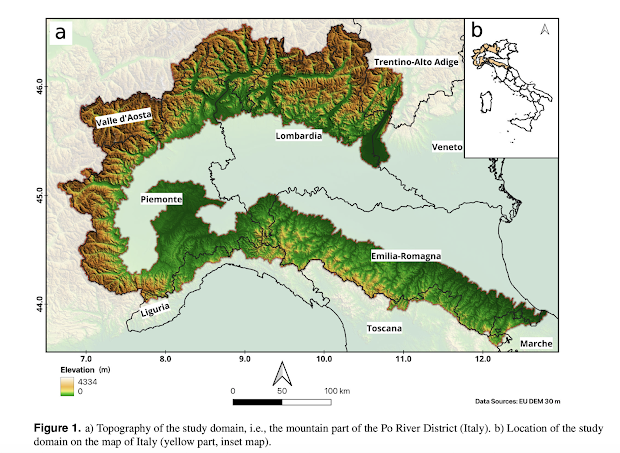My reflections and notes about hydrology and being a hydrologist in academia. The daily evolution of my work. Especially for my students, but also for anyone with the patience to read them.
Monday, September 30, 2024
Wednesday, September 25, 2024
The Rivers' Speech
Andrea Rinaldo is retiring. So young and strong I would say, he is only seventy now (seventy is the new forty, at least for him) and he will certainly continue to produce. Therefore the University of Padova is celebrating him on Friday, September 27 afternoon. He will talk about University and eventually some of his direct students, part of a family which now has grew wide and international, were asked to highlight for the general audience (in Italian) Andrea's research.
My topic was, quite obviously, geomorphology and river networks. Clicking below the figure you can find what I prepared in Italian (pre-recorded video here). Below The English version is here (pre-recorded video here). It is a short talk (8 minutes or so, but I hope that you like it). The complete records of the event in honor of Andrea Rinaldo can be found on YouTube.
A new way of discussing on the web with a distributed responsability
As many of you may know, recently, Jan Seibert issued an appeal to young hydrological researchers, advising caution when accepting invitations to become editors for review issues. In the past, these invitations were broadly distributed, but the results were often disappointing, leading to wasted time and effort. Demetris Koutsoyiannis, among others, raised opposing viewpoints, shifting the focus to the broader issues within scientific publishing and the influence large publishers can exert on the development of science.
This appeal was somewhat unusual for the AboutHydrology mailing list, which typically serves as an announcement platform, not a forum for discussion. Nevertheless, the topic quickly gained traction (considering the size of the community), with several prominent scientists contributing to the conversation. I eventually had to close the discussion within a day to prevent it from becoming overly repetitive. Despite its brevity, the conversation provided a good overview of the relevant perspectives.
### Key Takeaways:
1. Moderating a discussion list is surprisingly overwhelming.
2. A mailing list isn't the ideal platform for synthesizing differing opinions, but it can at least offer a quick overview of diverse perspectives on a given topic.
3. After a certain point, even well-informed and motivated contributions stop adding significant value.
4. Finding a suitable platform for discussion is essential.
5. A mailing list, despite its origins in fostering debate (like the old listserv model), is not the right tool for this anymore. Today, there are better alternatives.
Moderating such discussions is demanding, and moderators may not always have a vested interest in the topic. My proposed solution is a more distributed approach, where people can raise a question in a specialized application and share a link for feedback, allowing engagement without requiring users to join the application itself. The person who raises the question would be responsible for moderating that particular thread.
The ideal platform for AboutHydrology would be a tool designed for question pooling—something like an evolved version of *Klicker*, developed by the University of Zurich, where Jan works. *Klicker* allows questions to be posed and moderated, and users can respond via a shared link. This setup would allow the questioner to create a poll, share it on AboutHydrology, and gather feedback. At the end of the process, a report summarizing the responses could be distributed via the mailing list. While I have used the older version of *Klicker* with my students, I’m not yet proficient with the latest version.
Currently, one limitation of *Klicker* is that it doesn't seem to support direct interaction between users. However, here’s an example link to illustrate how it could work: [Jan’s opinion](https://pwa.klicker.uzh.ch/session/daf1a9ec-f26e-4ff4-ba79-30a8dd7b8cb6).
If anyone on the list knows of an alternative platform that might better suit this purpose, I’d appreciate recommendations and introductions to such tools.
Friday, September 13, 2024
A new tool for correcting the spatial and temporal pattern of global precipitation products across mountainous terrain: precipitation and hydrological analysis
This study primarily aims to integrate global precipitation data into hydrological models at the catchment scale, a common practice in hydrological research. Specifically, the study investigates how biased spatial and temporal patterns in precipitation data affectmodel performance and uncertainty. The European Meteorological Observations(EMO) and Climate Hazards Group InfraRed Precipitation with Station data (CHIRPS) global datasets are utilized as inputs for the GEOframe-NewAGE hydrological model to simulate the hydrological processes of the mountainous Aosta Valley catchment in northwestern Italy. The uncertainty of the hydrological model forced with global precipitation data is assessed using a proposed method called Empirical Conditional Probability (EcoProb). The results show that, although traditional performance metrics suggest similar outcomes for the model forced with EMO and CHIRPS, the proposed uncertainty analysis reveals higher uncertainty when CHIRPS is used as the precipitation input. To leverage all useful information in the global precipitation data, the spatial correlation of CHIRPS was combined with a subset of raingauges using the EcoProb method to modify the EMO precipitation data. This approach enabled the integration of the advantages of EMO and CHIRPS, which offer higher temporal and spatial correlation with ground observation, respectively, into a unified precipitation product. The combined dataset, referred to as the EcoProbSet product in this study, outperformed both the CHIRPS and EMO products, reducing the uncertainty introduced into hydrological models compared to the original global datasets.
You can find the paper preprint by clicking on the Figure above.






